Video Processing Application: Microservices Architecture Report
VerifiedAdded on 2022/11/25
|12
|2367
|186
Report
AI Summary
This report analyzes a video processing application currently using a monolithic architecture. It identifies stable modules (customer requirements, video planning, and account administration) and modules needing frequent modification (scripting, location search). It also highlights modules likely to face peak workloads (video planning, account administration, location search, approval engine, editing, graphics, and special effects). The report proposes refactoring the Location search & approval engine module first. It then details the impact of microservices on each module, emphasizing improved stability, agility, and scalability. The report discusses how microservices enhance high availability and presents an architectural diagram of the application after the transition to a microservice approach, breaking down the application into customer, video preparation, and post-production modules, each further divided into specific attributes for increased efficiency. The report concludes that a microservice approach can improve the efficiency and scalability of a monolithic application.
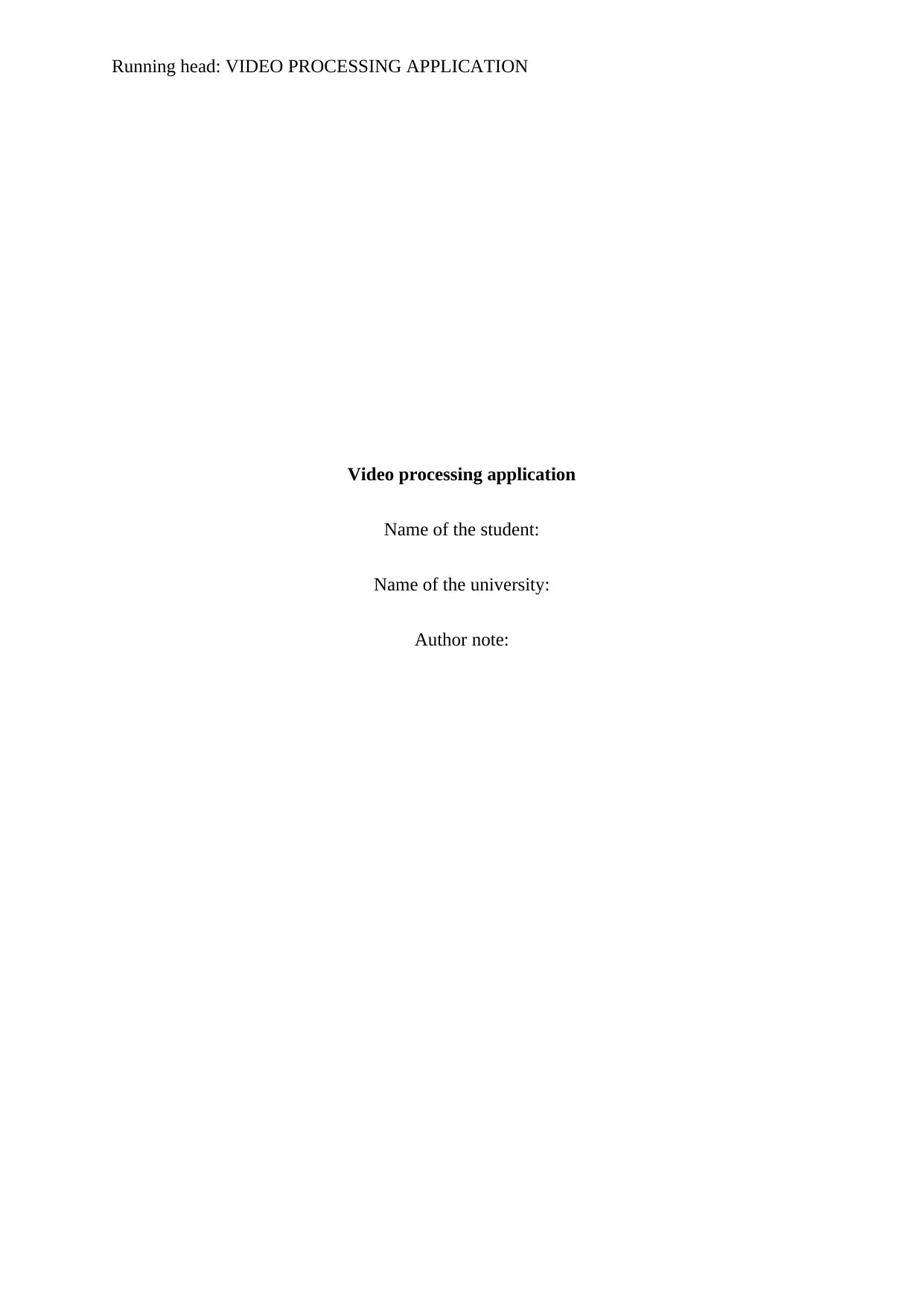
Running head: VIDEO PROCESSING APPLICATION
Video processing application
Name of the student:
Name of the university:
Author note:
Video processing application
Name of the student:
Name of the university:
Author note:
Paraphrase This Document
Need a fresh take? Get an instant paraphrase of this document with our AI Paraphraser
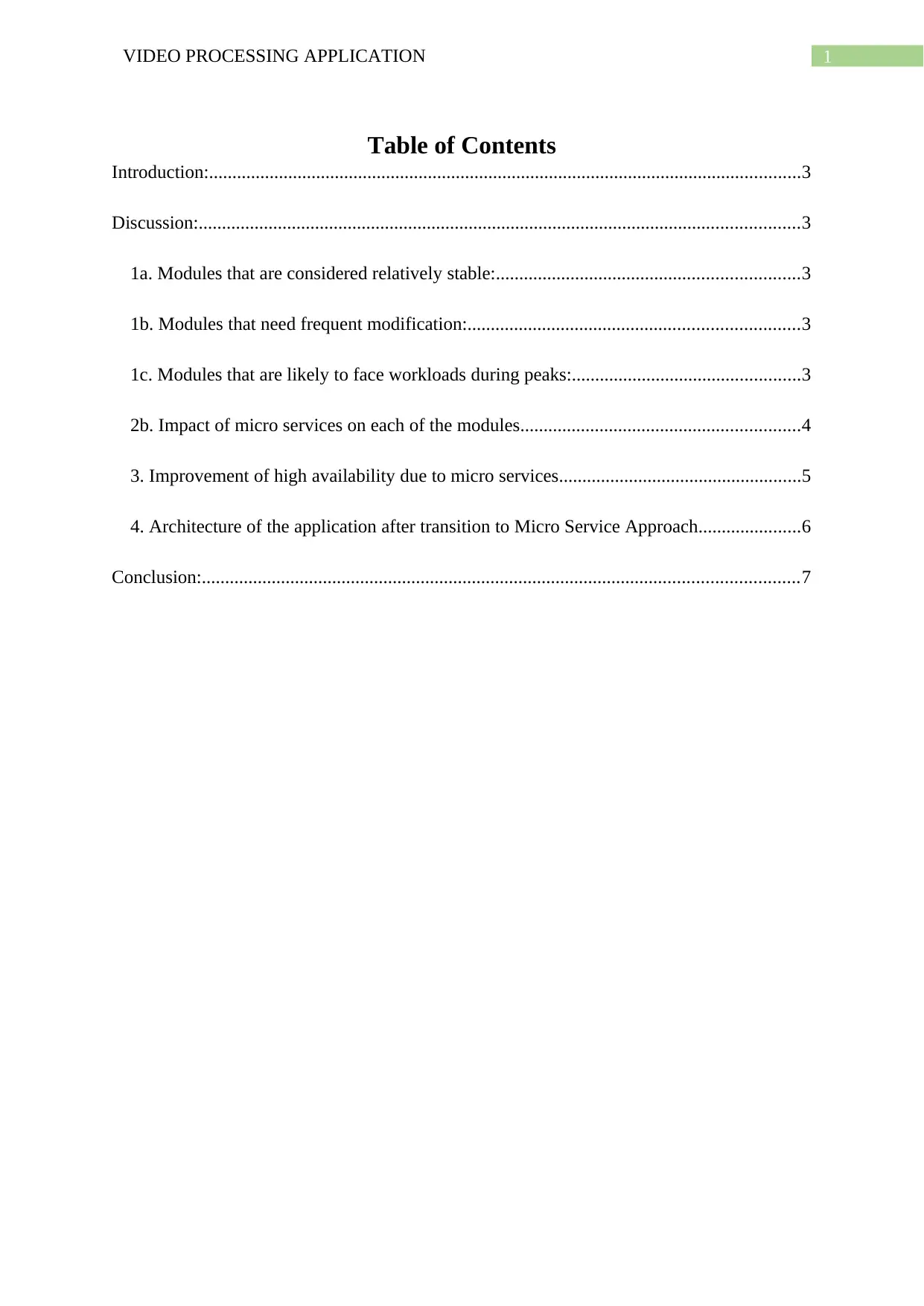
1VIDEO PROCESSING APPLICATION
Table of Contents
Introduction:...............................................................................................................................3
Discussion:.................................................................................................................................3
1a. Modules that are considered relatively stable:.................................................................3
1b. Modules that need frequent modification:.......................................................................3
1c. Modules that are likely to face workloads during peaks:.................................................3
2b. Impact of micro services on each of the modules............................................................4
3. Improvement of high availability due to micro services....................................................5
4. Architecture of the application after transition to Micro Service Approach......................6
Conclusion:................................................................................................................................7
Table of Contents
Introduction:...............................................................................................................................3
Discussion:.................................................................................................................................3
1a. Modules that are considered relatively stable:.................................................................3
1b. Modules that need frequent modification:.......................................................................3
1c. Modules that are likely to face workloads during peaks:.................................................3
2b. Impact of micro services on each of the modules............................................................4
3. Improvement of high availability due to micro services....................................................5
4. Architecture of the application after transition to Micro Service Approach......................6
Conclusion:................................................................................................................................7
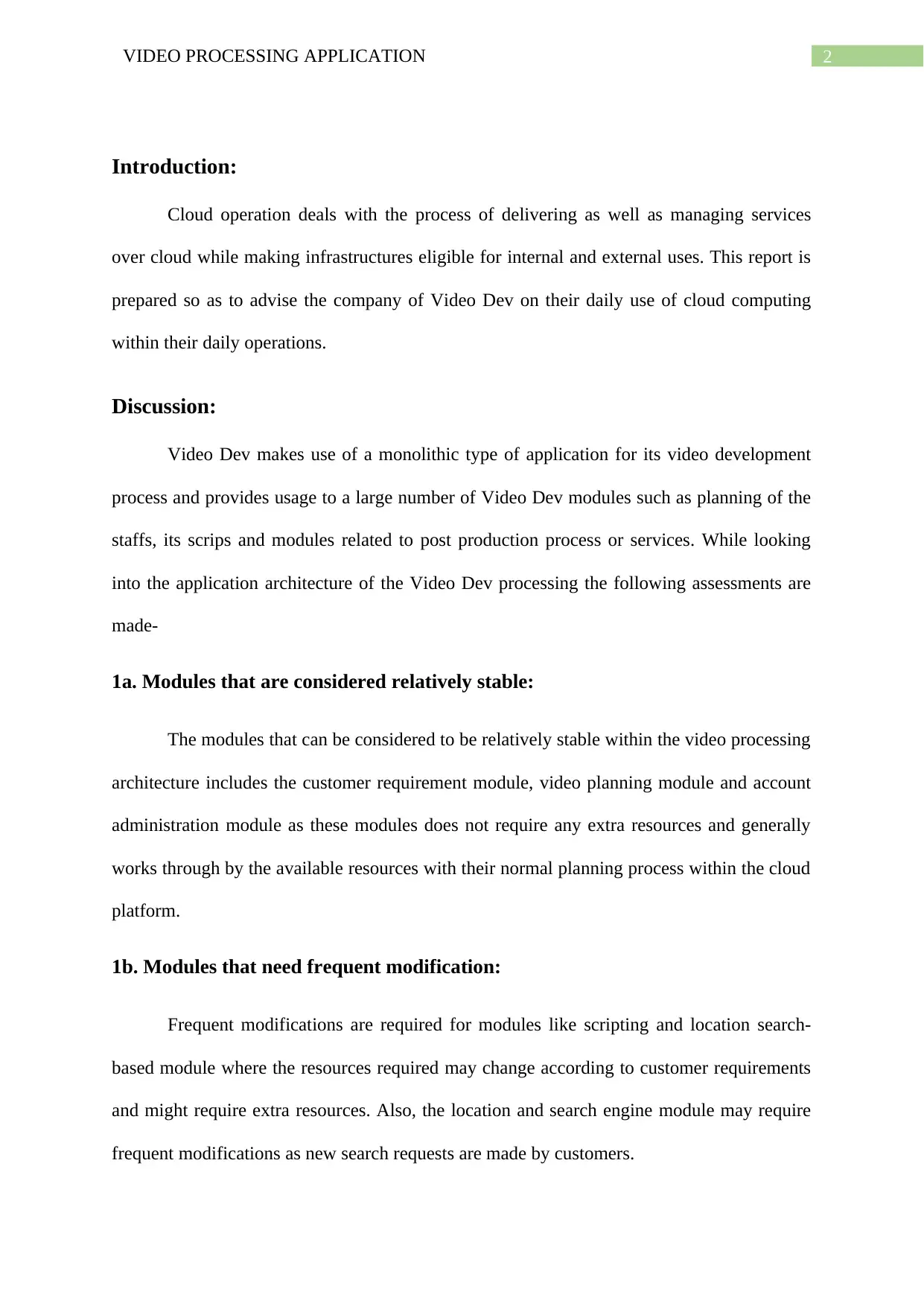
2VIDEO PROCESSING APPLICATION
Introduction:
Cloud operation deals with the process of delivering as well as managing services
over cloud while making infrastructures eligible for internal and external uses. This report is
prepared so as to advise the company of Video Dev on their daily use of cloud computing
within their daily operations.
Discussion:
Video Dev makes use of a monolithic type of application for its video development
process and provides usage to a large number of Video Dev modules such as planning of the
staffs, its scrips and modules related to post production process or services. While looking
into the application architecture of the Video Dev processing the following assessments are
made-
1a. Modules that are considered relatively stable:
The modules that can be considered to be relatively stable within the video processing
architecture includes the customer requirement module, video planning module and account
administration module as these modules does not require any extra resources and generally
works through by the available resources with their normal planning process within the cloud
platform.
1b. Modules that need frequent modification:
Frequent modifications are required for modules like scripting and location search-
based module where the resources required may change according to customer requirements
and might require extra resources. Also, the location and search engine module may require
frequent modifications as new search requests are made by customers.
Introduction:
Cloud operation deals with the process of delivering as well as managing services
over cloud while making infrastructures eligible for internal and external uses. This report is
prepared so as to advise the company of Video Dev on their daily use of cloud computing
within their daily operations.
Discussion:
Video Dev makes use of a monolithic type of application for its video development
process and provides usage to a large number of Video Dev modules such as planning of the
staffs, its scrips and modules related to post production process or services. While looking
into the application architecture of the Video Dev processing the following assessments are
made-
1a. Modules that are considered relatively stable:
The modules that can be considered to be relatively stable within the video processing
architecture includes the customer requirement module, video planning module and account
administration module as these modules does not require any extra resources and generally
works through by the available resources with their normal planning process within the cloud
platform.
1b. Modules that need frequent modification:
Frequent modifications are required for modules like scripting and location search-
based module where the resources required may change according to customer requirements
and might require extra resources. Also, the location and search engine module may require
frequent modifications as new search requests are made by customers.
⊘ This is a preview!⊘
Do you want full access?
Subscribe today to unlock all pages.

Trusted by 1+ million students worldwide
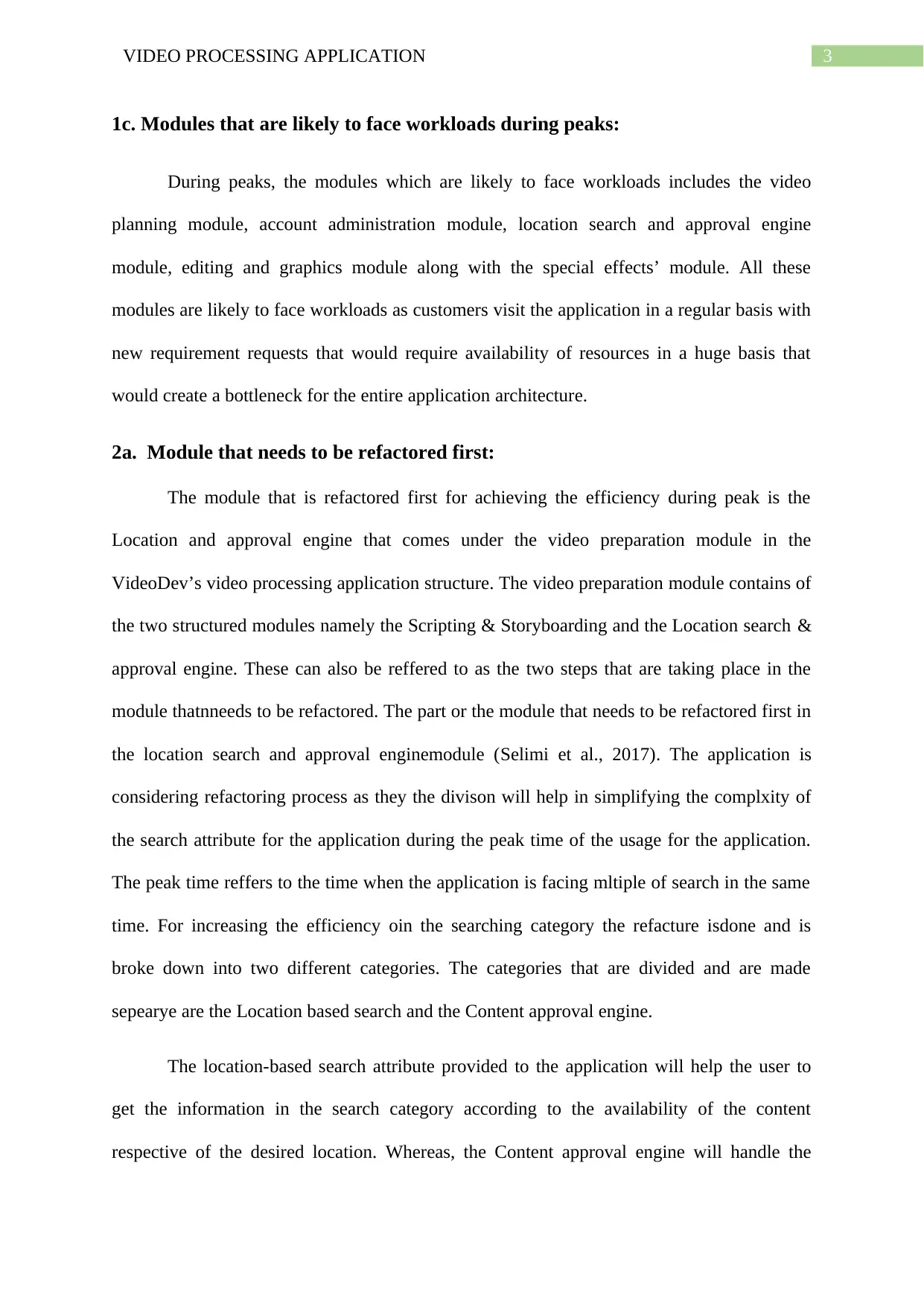
3VIDEO PROCESSING APPLICATION
1c. Modules that are likely to face workloads during peaks:
During peaks, the modules which are likely to face workloads includes the video
planning module, account administration module, location search and approval engine
module, editing and graphics module along with the special effects’ module. All these
modules are likely to face workloads as customers visit the application in a regular basis with
new requirement requests that would require availability of resources in a huge basis that
would create a bottleneck for the entire application architecture.
2a. Module that needs to be refactored first:
The module that is refactored first for achieving the efficiency during peak is the
Location and approval engine that comes under the video preparation module in the
VideoDev’s video processing application structure. The video preparation module contains of
the two structured modules namely the Scripting & Storyboarding and the Location search &
approval engine. These can also be reffered to as the two steps that are taking place in the
module thatnneeds to be refactored. The part or the module that needs to be refactored first in
the location search and approval enginemodule (Selimi et al., 2017). The application is
considering refactoring process as they the divison will help in simplifying the complxity of
the search attribute for the application during the peak time of the usage for the application.
The peak time reffers to the time when the application is facing mltiple of search in the same
time. For increasing the efficiency oin the searching category the refacture isdone and is
broke down into two different categories. The categories that are divided and are made
sepearye are the Location based search and the Content approval engine.
The location-based search attribute provided to the application will help the user to
get the information in the search category according to the availability of the content
respective of the desired location. Whereas, the Content approval engine will handle the
1c. Modules that are likely to face workloads during peaks:
During peaks, the modules which are likely to face workloads includes the video
planning module, account administration module, location search and approval engine
module, editing and graphics module along with the special effects’ module. All these
modules are likely to face workloads as customers visit the application in a regular basis with
new requirement requests that would require availability of resources in a huge basis that
would create a bottleneck for the entire application architecture.
2a. Module that needs to be refactored first:
The module that is refactored first for achieving the efficiency during peak is the
Location and approval engine that comes under the video preparation module in the
VideoDev’s video processing application structure. The video preparation module contains of
the two structured modules namely the Scripting & Storyboarding and the Location search &
approval engine. These can also be reffered to as the two steps that are taking place in the
module thatnneeds to be refactored. The part or the module that needs to be refactored first in
the location search and approval enginemodule (Selimi et al., 2017). The application is
considering refactoring process as they the divison will help in simplifying the complxity of
the search attribute for the application during the peak time of the usage for the application.
The peak time reffers to the time when the application is facing mltiple of search in the same
time. For increasing the efficiency oin the searching category the refacture isdone and is
broke down into two different categories. The categories that are divided and are made
sepearye are the Location based search and the Content approval engine.
The location-based search attribute provided to the application will help the user to
get the information in the search category according to the availability of the content
respective of the desired location. Whereas, the Content approval engine will handle the
Paraphrase This Document
Need a fresh take? Get an instant paraphrase of this document with our AI Paraphraser
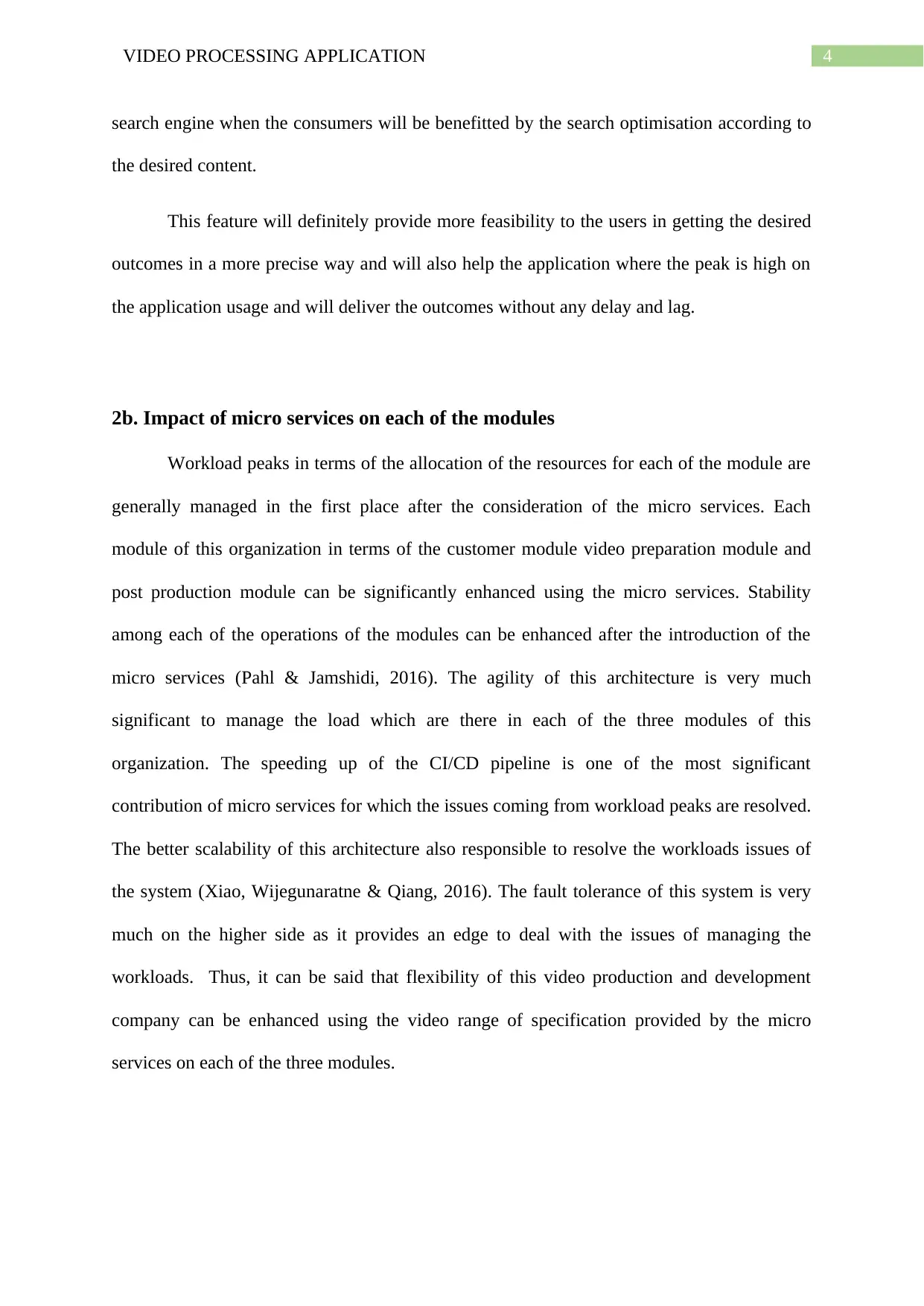
4VIDEO PROCESSING APPLICATION
search engine when the consumers will be benefitted by the search optimisation according to
the desired content.
This feature will definitely provide more feasibility to the users in getting the desired
outcomes in a more precise way and will also help the application where the peak is high on
the application usage and will deliver the outcomes without any delay and lag.
2b. Impact of micro services on each of the modules
Workload peaks in terms of the allocation of the resources for each of the module are
generally managed in the first place after the consideration of the micro services. Each
module of this organization in terms of the customer module video preparation module and
post production module can be significantly enhanced using the micro services. Stability
among each of the operations of the modules can be enhanced after the introduction of the
micro services (Pahl & Jamshidi, 2016). The agility of this architecture is very much
significant to manage the load which are there in each of the three modules of this
organization. The speeding up of the CI/CD pipeline is one of the most significant
contribution of micro services for which the issues coming from workload peaks are resolved.
The better scalability of this architecture also responsible to resolve the workloads issues of
the system (Xiao, Wijegunaratne & Qiang, 2016). The fault tolerance of this system is very
much on the higher side as it provides an edge to deal with the issues of managing the
workloads. Thus, it can be said that flexibility of this video production and development
company can be enhanced using the video range of specification provided by the micro
services on each of the three modules.
search engine when the consumers will be benefitted by the search optimisation according to
the desired content.
This feature will definitely provide more feasibility to the users in getting the desired
outcomes in a more precise way and will also help the application where the peak is high on
the application usage and will deliver the outcomes without any delay and lag.
2b. Impact of micro services on each of the modules
Workload peaks in terms of the allocation of the resources for each of the module are
generally managed in the first place after the consideration of the micro services. Each
module of this organization in terms of the customer module video preparation module and
post production module can be significantly enhanced using the micro services. Stability
among each of the operations of the modules can be enhanced after the introduction of the
micro services (Pahl & Jamshidi, 2016). The agility of this architecture is very much
significant to manage the load which are there in each of the three modules of this
organization. The speeding up of the CI/CD pipeline is one of the most significant
contribution of micro services for which the issues coming from workload peaks are resolved.
The better scalability of this architecture also responsible to resolve the workloads issues of
the system (Xiao, Wijegunaratne & Qiang, 2016). The fault tolerance of this system is very
much on the higher side as it provides an edge to deal with the issues of managing the
workloads. Thus, it can be said that flexibility of this video production and development
company can be enhanced using the video range of specification provided by the micro
services on each of the three modules.
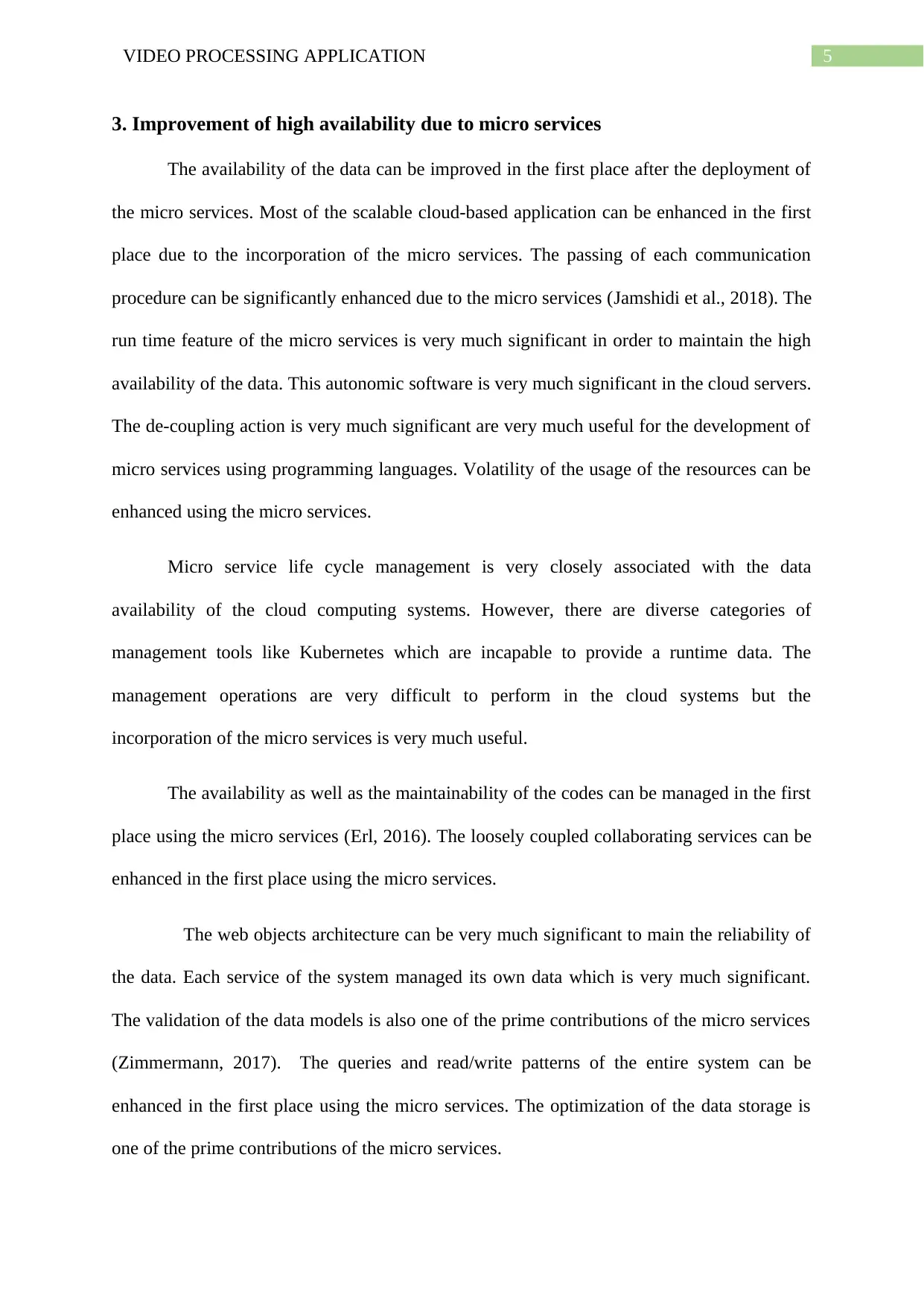
5VIDEO PROCESSING APPLICATION
3. Improvement of high availability due to micro services
The availability of the data can be improved in the first place after the deployment of
the micro services. Most of the scalable cloud-based application can be enhanced in the first
place due to the incorporation of the micro services. The passing of each communication
procedure can be significantly enhanced due to the micro services (Jamshidi et al., 2018). The
run time feature of the micro services is very much significant in order to maintain the high
availability of the data. This autonomic software is very much significant in the cloud servers.
The de-coupling action is very much significant are very much useful for the development of
micro services using programming languages. Volatility of the usage of the resources can be
enhanced using the micro services.
Micro service life cycle management is very closely associated with the data
availability of the cloud computing systems. However, there are diverse categories of
management tools like Kubernetes which are incapable to provide a runtime data. The
management operations are very difficult to perform in the cloud systems but the
incorporation of the micro services is very much useful.
The availability as well as the maintainability of the codes can be managed in the first
place using the micro services (Erl, 2016). The loosely coupled collaborating services can be
enhanced in the first place using the micro services.
The web objects architecture can be very much significant to main the reliability of
the data. Each service of the system managed its own data which is very much significant.
The validation of the data models is also one of the prime contributions of the micro services
(Zimmermann, 2017). The queries and read/write patterns of the entire system can be
enhanced in the first place using the micro services. The optimization of the data storage is
one of the prime contributions of the micro services.
3. Improvement of high availability due to micro services
The availability of the data can be improved in the first place after the deployment of
the micro services. Most of the scalable cloud-based application can be enhanced in the first
place due to the incorporation of the micro services. The passing of each communication
procedure can be significantly enhanced due to the micro services (Jamshidi et al., 2018). The
run time feature of the micro services is very much significant in order to maintain the high
availability of the data. This autonomic software is very much significant in the cloud servers.
The de-coupling action is very much significant are very much useful for the development of
micro services using programming languages. Volatility of the usage of the resources can be
enhanced using the micro services.
Micro service life cycle management is very closely associated with the data
availability of the cloud computing systems. However, there are diverse categories of
management tools like Kubernetes which are incapable to provide a runtime data. The
management operations are very difficult to perform in the cloud systems but the
incorporation of the micro services is very much useful.
The availability as well as the maintainability of the codes can be managed in the first
place using the micro services (Erl, 2016). The loosely coupled collaborating services can be
enhanced in the first place using the micro services.
The web objects architecture can be very much significant to main the reliability of
the data. Each service of the system managed its own data which is very much significant.
The validation of the data models is also one of the prime contributions of the micro services
(Zimmermann, 2017). The queries and read/write patterns of the entire system can be
enhanced in the first place using the micro services. The optimization of the data storage is
one of the prime contributions of the micro services.
⊘ This is a preview!⊘
Do you want full access?
Subscribe today to unlock all pages.

Trusted by 1+ million students worldwide
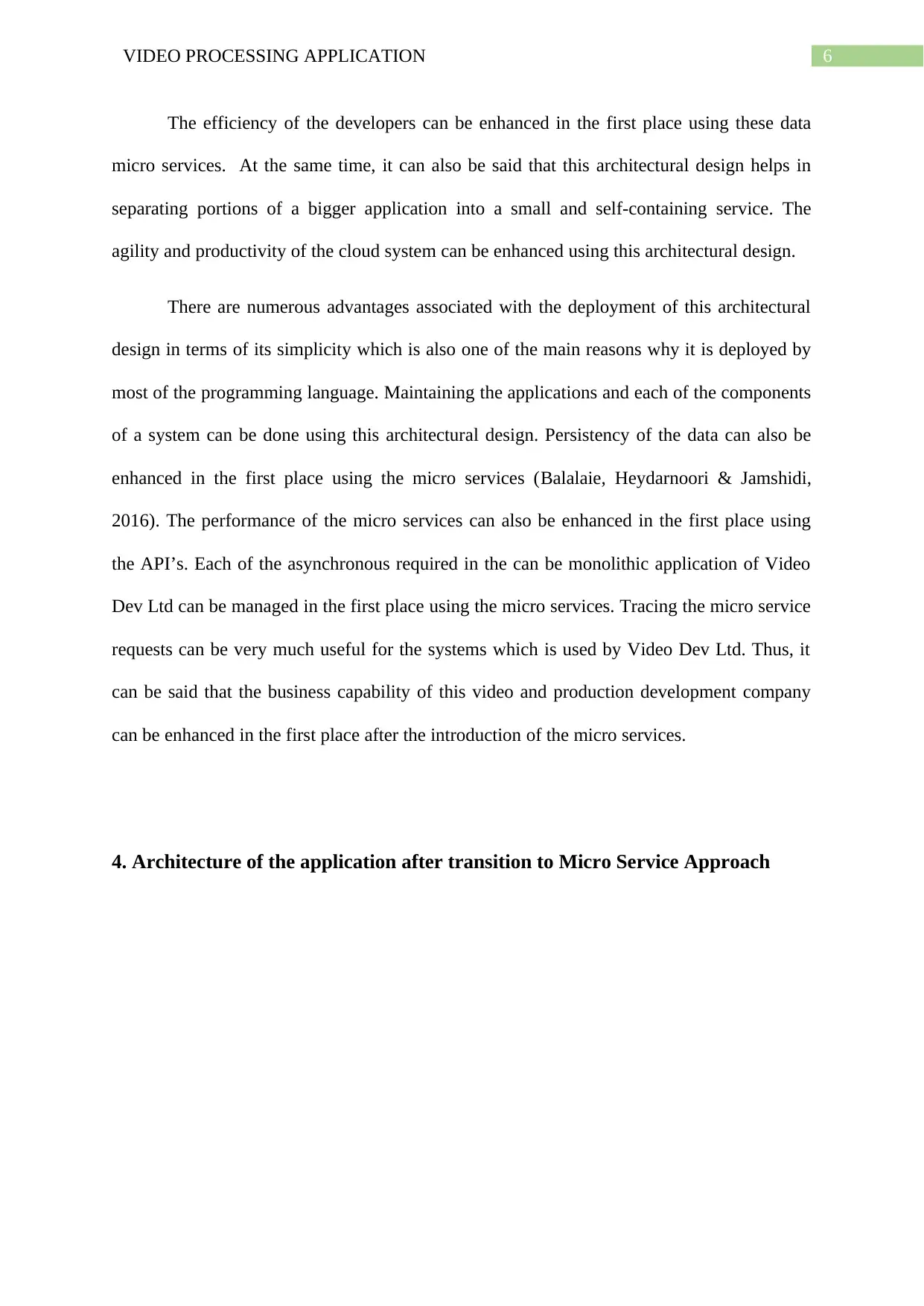
6VIDEO PROCESSING APPLICATION
The efficiency of the developers can be enhanced in the first place using these data
micro services. At the same time, it can also be said that this architectural design helps in
separating portions of a bigger application into a small and self-containing service. The
agility and productivity of the cloud system can be enhanced using this architectural design.
There are numerous advantages associated with the deployment of this architectural
design in terms of its simplicity which is also one of the main reasons why it is deployed by
most of the programming language. Maintaining the applications and each of the components
of a system can be done using this architectural design. Persistency of the data can also be
enhanced in the first place using the micro services (Balalaie, Heydarnoori & Jamshidi,
2016). The performance of the micro services can also be enhanced in the first place using
the API’s. Each of the asynchronous required in the can be monolithic application of Video
Dev Ltd can be managed in the first place using the micro services. Tracing the micro service
requests can be very much useful for the systems which is used by Video Dev Ltd. Thus, it
can be said that the business capability of this video and production development company
can be enhanced in the first place after the introduction of the micro services.
4. Architecture of the application after transition to Micro Service Approach
The efficiency of the developers can be enhanced in the first place using these data
micro services. At the same time, it can also be said that this architectural design helps in
separating portions of a bigger application into a small and self-containing service. The
agility and productivity of the cloud system can be enhanced using this architectural design.
There are numerous advantages associated with the deployment of this architectural
design in terms of its simplicity which is also one of the main reasons why it is deployed by
most of the programming language. Maintaining the applications and each of the components
of a system can be done using this architectural design. Persistency of the data can also be
enhanced in the first place using the micro services (Balalaie, Heydarnoori & Jamshidi,
2016). The performance of the micro services can also be enhanced in the first place using
the API’s. Each of the asynchronous required in the can be monolithic application of Video
Dev Ltd can be managed in the first place using the micro services. Tracing the micro service
requests can be very much useful for the systems which is used by Video Dev Ltd. Thus, it
can be said that the business capability of this video and production development company
can be enhanced in the first place after the introduction of the micro services.
4. Architecture of the application after transition to Micro Service Approach
Paraphrase This Document
Need a fresh take? Get an instant paraphrase of this document with our AI Paraphraser
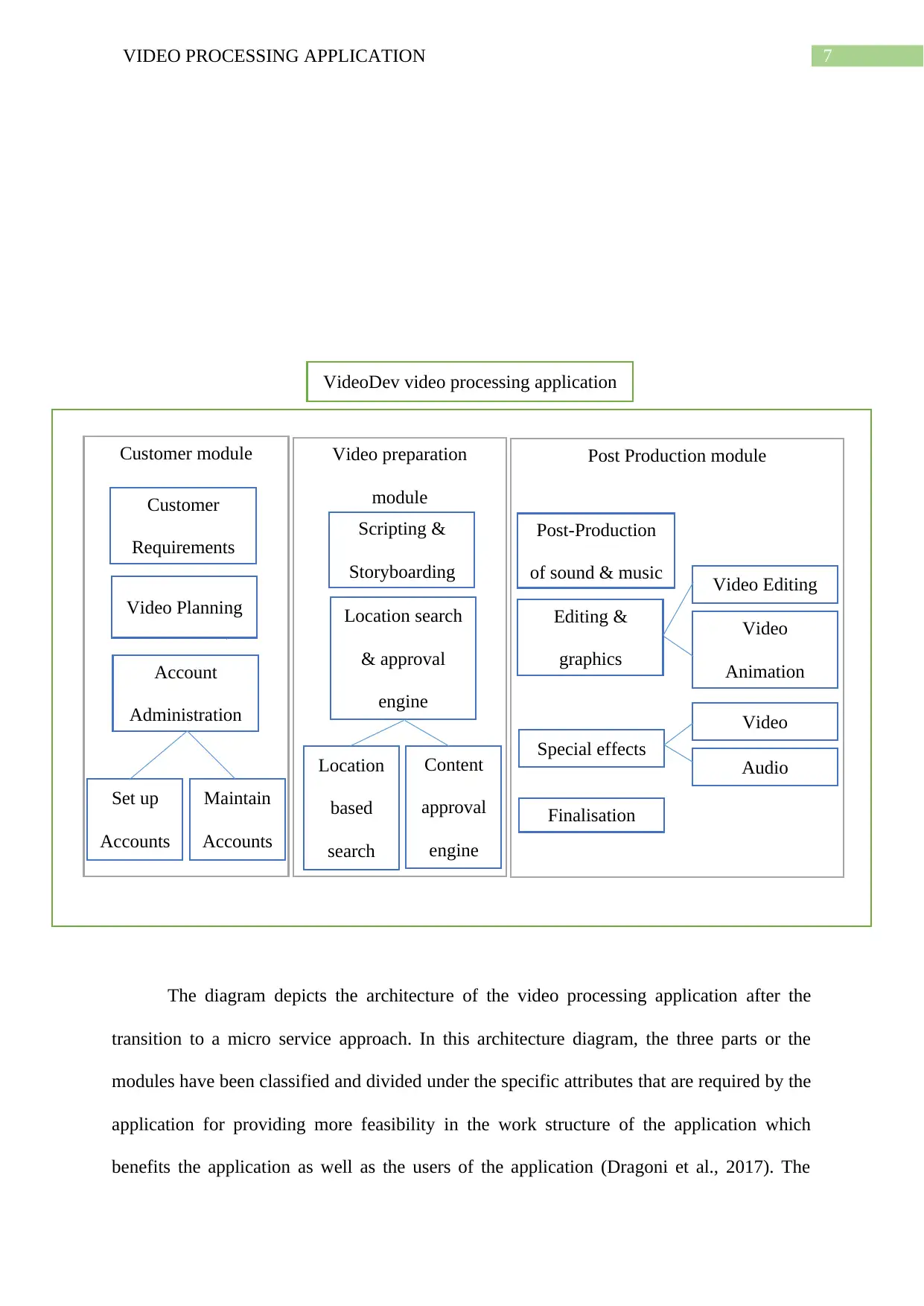
7VIDEO PROCESSING APPLICATION
The diagram depicts the architecture of the video processing application after the
transition to a micro service approach. In this architecture diagram, the three parts or the
modules have been classified and divided under the specific attributes that are required by the
application for providing more feasibility in the work structure of the application which
benefits the application as well as the users of the application (Dragoni et al., 2017). The
Customer module
Customer
Requirements
Video Planning
Account
Administration
Set up
Accounts
Maintain
Accounts
Video preparation
module
Scripting &
Storyboarding
Location search
& approval
engine
Location
based
search
Content
approval
engine
Post Production module
Post-Production
of sound & music
Editing &
graphics
Special effects
Finalisation
Video Editing
Video
Animation
Video
Audio
VideoDev video processing application
The diagram depicts the architecture of the video processing application after the
transition to a micro service approach. In this architecture diagram, the three parts or the
modules have been classified and divided under the specific attributes that are required by the
application for providing more feasibility in the work structure of the application which
benefits the application as well as the users of the application (Dragoni et al., 2017). The
Customer module
Customer
Requirements
Video Planning
Account
Administration
Set up
Accounts
Maintain
Accounts
Video preparation
module
Scripting &
Storyboarding
Location search
& approval
engine
Location
based
search
Content
approval
engine
Post Production module
Post-Production
of sound & music
Editing &
graphics
Special effects
Finalisation
Video Editing
Video
Animation
Video
Audio
VideoDev video processing application
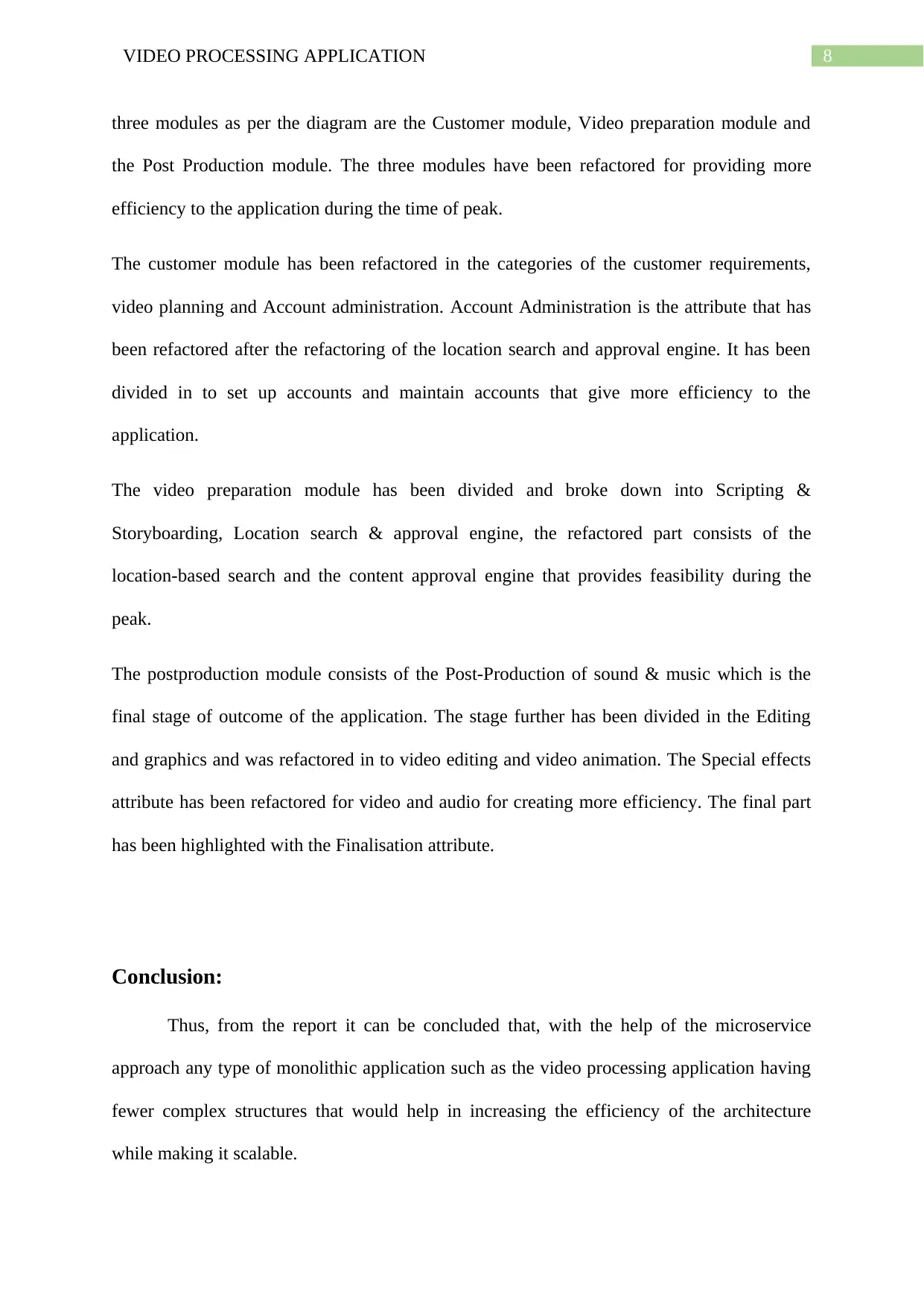
8VIDEO PROCESSING APPLICATION
three modules as per the diagram are the Customer module, Video preparation module and
the Post Production module. The three modules have been refactored for providing more
efficiency to the application during the time of peak.
The customer module has been refactored in the categories of the customer requirements,
video planning and Account administration. Account Administration is the attribute that has
been refactored after the refactoring of the location search and approval engine. It has been
divided in to set up accounts and maintain accounts that give more efficiency to the
application.
The video preparation module has been divided and broke down into Scripting &
Storyboarding, Location search & approval engine, the refactored part consists of the
location-based search and the content approval engine that provides feasibility during the
peak.
The postproduction module consists of the Post-Production of sound & music which is the
final stage of outcome of the application. The stage further has been divided in the Editing
and graphics and was refactored in to video editing and video animation. The Special effects
attribute has been refactored for video and audio for creating more efficiency. The final part
has been highlighted with the Finalisation attribute.
Conclusion:
Thus, from the report it can be concluded that, with the help of the microservice
approach any type of monolithic application such as the video processing application having
fewer complex structures that would help in increasing the efficiency of the architecture
while making it scalable.
three modules as per the diagram are the Customer module, Video preparation module and
the Post Production module. The three modules have been refactored for providing more
efficiency to the application during the time of peak.
The customer module has been refactored in the categories of the customer requirements,
video planning and Account administration. Account Administration is the attribute that has
been refactored after the refactoring of the location search and approval engine. It has been
divided in to set up accounts and maintain accounts that give more efficiency to the
application.
The video preparation module has been divided and broke down into Scripting &
Storyboarding, Location search & approval engine, the refactored part consists of the
location-based search and the content approval engine that provides feasibility during the
peak.
The postproduction module consists of the Post-Production of sound & music which is the
final stage of outcome of the application. The stage further has been divided in the Editing
and graphics and was refactored in to video editing and video animation. The Special effects
attribute has been refactored for video and audio for creating more efficiency. The final part
has been highlighted with the Finalisation attribute.
Conclusion:
Thus, from the report it can be concluded that, with the help of the microservice
approach any type of monolithic application such as the video processing application having
fewer complex structures that would help in increasing the efficiency of the architecture
while making it scalable.
⊘ This is a preview!⊘
Do you want full access?
Subscribe today to unlock all pages.

Trusted by 1+ million students worldwide

9VIDEO PROCESSING APPLICATION
Paraphrase This Document
Need a fresh take? Get an instant paraphrase of this document with our AI Paraphraser
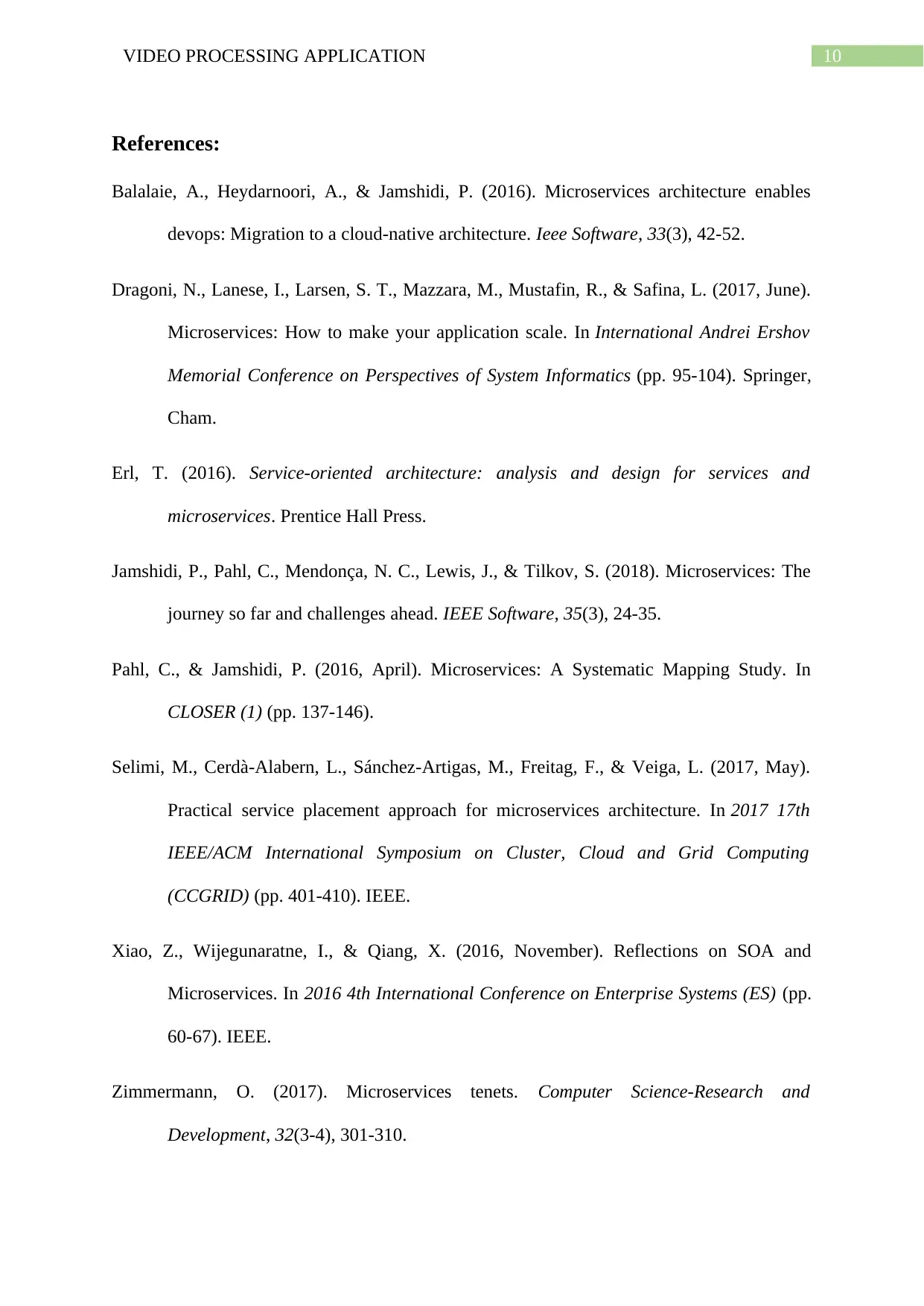
10VIDEO PROCESSING APPLICATION
References:
Balalaie, A., Heydarnoori, A., & Jamshidi, P. (2016). Microservices architecture enables
devops: Migration to a cloud-native architecture. Ieee Software, 33(3), 42-52.
Dragoni, N., Lanese, I., Larsen, S. T., Mazzara, M., Mustafin, R., & Safina, L. (2017, June).
Microservices: How to make your application scale. In International Andrei Ershov
Memorial Conference on Perspectives of System Informatics (pp. 95-104). Springer,
Cham.
Erl, T. (2016). Service-oriented architecture: analysis and design for services and
microservices. Prentice Hall Press.
Jamshidi, P., Pahl, C., Mendonça, N. C., Lewis, J., & Tilkov, S. (2018). Microservices: The
journey so far and challenges ahead. IEEE Software, 35(3), 24-35.
Pahl, C., & Jamshidi, P. (2016, April). Microservices: A Systematic Mapping Study. In
CLOSER (1) (pp. 137-146).
Selimi, M., Cerdà-Alabern, L., Sánchez-Artigas, M., Freitag, F., & Veiga, L. (2017, May).
Practical service placement approach for microservices architecture. In 2017 17th
IEEE/ACM International Symposium on Cluster, Cloud and Grid Computing
(CCGRID) (pp. 401-410). IEEE.
Xiao, Z., Wijegunaratne, I., & Qiang, X. (2016, November). Reflections on SOA and
Microservices. In 2016 4th International Conference on Enterprise Systems (ES) (pp.
60-67). IEEE.
Zimmermann, O. (2017). Microservices tenets. Computer Science-Research and
Development, 32(3-4), 301-310.
References:
Balalaie, A., Heydarnoori, A., & Jamshidi, P. (2016). Microservices architecture enables
devops: Migration to a cloud-native architecture. Ieee Software, 33(3), 42-52.
Dragoni, N., Lanese, I., Larsen, S. T., Mazzara, M., Mustafin, R., & Safina, L. (2017, June).
Microservices: How to make your application scale. In International Andrei Ershov
Memorial Conference on Perspectives of System Informatics (pp. 95-104). Springer,
Cham.
Erl, T. (2016). Service-oriented architecture: analysis and design for services and
microservices. Prentice Hall Press.
Jamshidi, P., Pahl, C., Mendonça, N. C., Lewis, J., & Tilkov, S. (2018). Microservices: The
journey so far and challenges ahead. IEEE Software, 35(3), 24-35.
Pahl, C., & Jamshidi, P. (2016, April). Microservices: A Systematic Mapping Study. In
CLOSER (1) (pp. 137-146).
Selimi, M., Cerdà-Alabern, L., Sánchez-Artigas, M., Freitag, F., & Veiga, L. (2017, May).
Practical service placement approach for microservices architecture. In 2017 17th
IEEE/ACM International Symposium on Cluster, Cloud and Grid Computing
(CCGRID) (pp. 401-410). IEEE.
Xiao, Z., Wijegunaratne, I., & Qiang, X. (2016, November). Reflections on SOA and
Microservices. In 2016 4th International Conference on Enterprise Systems (ES) (pp.
60-67). IEEE.
Zimmermann, O. (2017). Microservices tenets. Computer Science-Research and
Development, 32(3-4), 301-310.

11VIDEO PROCESSING APPLICATION
⊘ This is a preview!⊘
Do you want full access?
Subscribe today to unlock all pages.

Trusted by 1+ million students worldwide
1 out of 12
Related Documents
Your All-in-One AI-Powered Toolkit for Academic Success.
+13062052269
info@desklib.com
Available 24*7 on WhatsApp / Email
![[object Object]](/_next/static/media/star-bottom.7253800d.svg)
Unlock your academic potential
Copyright © 2020–2025 A2Z Services. All Rights Reserved. Developed and managed by ZUCOL.





